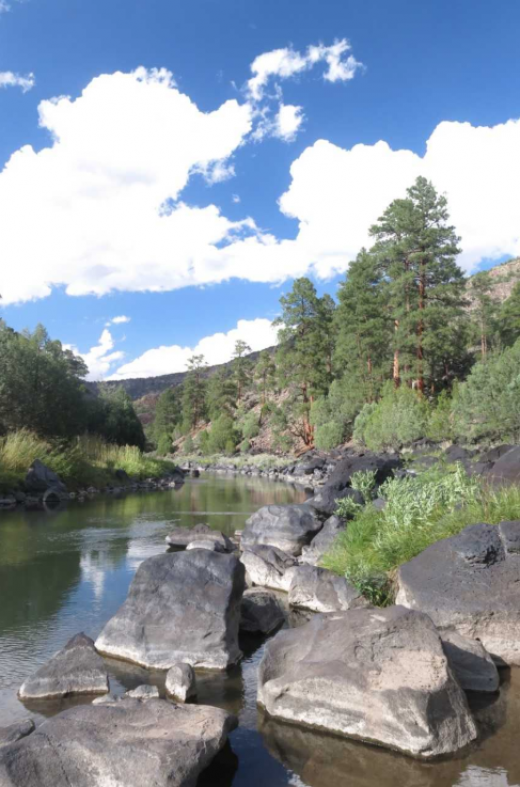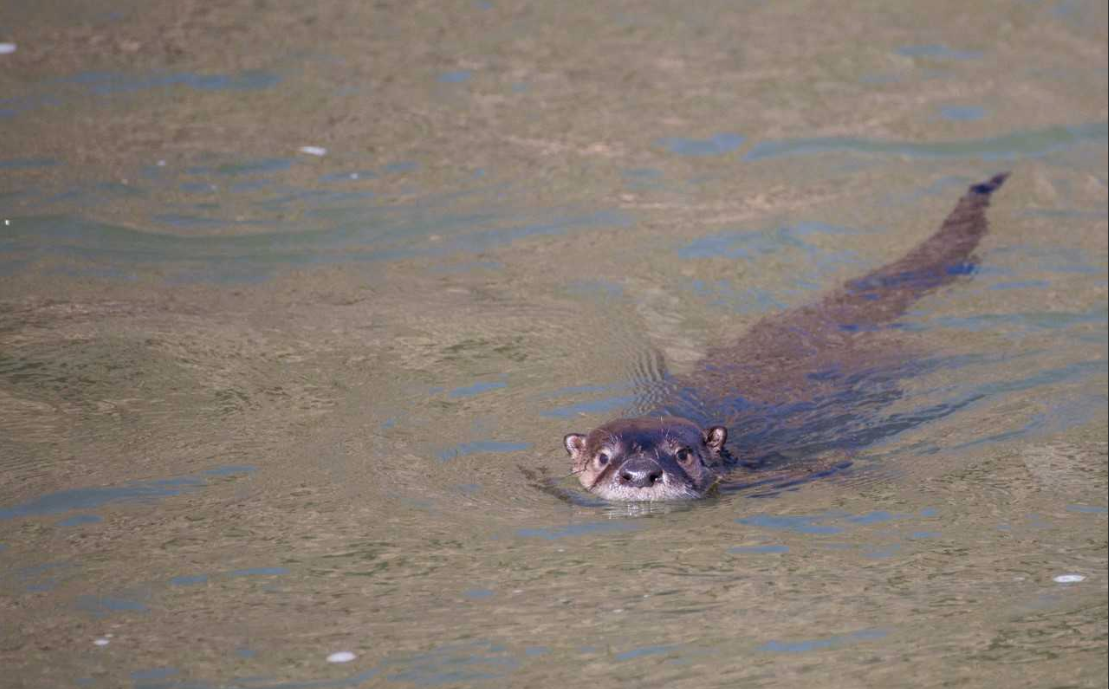Photo courtesy of Nick Streit
By Toner Mitchell
While binge fishing the Rio Grande gorge last week, I saw my first two otters in New Mexico. Regarding the second, I’d yet to take my first cast when a long, chocolate movement caught the corner of my eye and drew my attention to the animal waddling into the pool downstream. The next thing I knew, it had closed the distance between us to about 25 feet. The otter stared at me, treading water in a rapid like it was nothing. Instead of sprinting for the bushes as he usually does when seeing a beast for the first time, my dog jumped into the water and gave chase. The otter disappeared like a mirage.
It could have been the same animal as the one I’d seen a couple days before about a half mile upstream. Probably not though, the upstream otter seemed smaller. In a deliciously churning pocket, I’d expected to catch more than one fish until its wide nose and tiny black eyes surfaced within a couple feet of my drifting spruce moth imitation. A couple holes back, I’d just released a 19-inch, heavily muscled specimen of a rainbow after a long fight. Upon seeing the otter, I thought of the fish again and prayed that he was recovering in a hole beneath a chunk of basalt.
Here’s a machine gun of truths about the Rio Grande’s otters. They were reintroduced to the river in 2005 after being trapped to extirpation around the turn of the 20th century. They’ve since distributed as far down as Cochiti Reservoir (120 miles from the release point) and in tributaries such as the Rios Pueblo and Hondo. Their heavy winter presence in the Red River correlates to a sharp decrease in observed trout spawning in that tributary. The Rio Grande del Norte National Monument was in part sold to the local community on the promise of economic development based on tourism, to which high-quality fishing (and wildlife viewing) contribute significantly. Otters eat trout, but they prefer slower prey: suckers, carp, pike, freshwater snails, crayfish, and amphibians. Most of these critters aren’t native to the gorge, excepting the Rio Grande sucker and chub, which are both pushing endangered status. Rainbow and brown trout aren’t native either, and the current otter population was seeded with individuals from the Pacific Northwest. Increasingly, Rio anglers are catching more Rio Grande cutthroat trout, New Mexico’s state fish, and for the record, grown in a hatchery 100 miles distant.
Last but not least, otters are extremely cute. And anglers, thanks to what they believe to be impacts on Red River spawners, were beginning to hate them. I say “were” because the issue isn’t as clear as many had thought even recently. According to many anglers and guides, there are fewer big trout in the Rio these days, and many more little ones. The Red has a good stock of smallish fish, even if the spawners don’t seem to come around — or live — as much.
Carp, pike and crayfish aren’t as common as they used to be. Another trend is evolving in the fishing community itself, a group that was speeding towards a militant anti-otter bias with ever-balding brake pads just a few short months ago. We are being reminded of ecological nuance. Instead of saying, “This is what’s happening, and it’s the otters’ fault,” we now say, “This is what seems to be happening. Is it good or is it bad?” I’m relieved by this development, if only because the world’s had enough of sportsmen who couldn’t have cared less about ecology suddenly becoming scientists at the chance of going to war with a predator.
 Joking aside, it just seems more productive to slow down a bit and simply observe. Otters have been in the Rio Grande now for almost 14 years. If we looked diligently enough, we could find impacts on trout: there might be fewer big fish, and there might be more fish or healthier fish because otters are eating things that eat trout eggs. One thing I’d be willing to bet on is that the river, especially in the Monument where it is protected from threats worse than otters, is in the best position to take care of its problems. Since the otters arrived, there seems to be an ecological give and take that wasn’t there before. After my dog chased the second otter off, I kept turning around, part wishing he was still there and, because the fishing was heating up, part wishing he’d scram. Either way, I was destined for the same place.
Joking aside, it just seems more productive to slow down a bit and simply observe. Otters have been in the Rio Grande now for almost 14 years. If we looked diligently enough, we could find impacts on trout: there might be fewer big fish, and there might be more fish or healthier fish because otters are eating things that eat trout eggs. One thing I’d be willing to bet on is that the river, especially in the Monument where it is protected from threats worse than otters, is in the best position to take care of its problems. Since the otters arrived, there seems to be an ecological give and take that wasn’t there before. After my dog chased the second otter off, I kept turning around, part wishing he was still there and, because the fishing was heating up, part wishing he’d scram. Either way, I was destined for the same place.
The sky had turned black. Raindrops as big as dimes splashed against basalt, shining it as black as obsidian as the thunder grew louder and closer. A bolt of lightning reminded me that dying while fishing had always been how I wanted to go, preferably with a fish on the line, which was suddenly the case. For at least a moment, I really thought it was going to happen. I even tried (and failed) to wish for my own death.
“Am I ready?” I thought. No one is ever ready, because no one truly knows what’s just around the corner. Imagine being a Rio Grande trout encountering a reintroduced otter. Or the trout after that, a sucker, carp, or crayfish. Some of them die, ready or not. And some of them live. Like the fish on my line that day I thought the storm would take me, some of them get away.
Toner Mitchell is the TU’s New Mexico water and habitat coordinator. He lives and works in Santa Fe.



